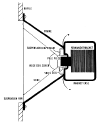| How loudspeakers work | 
|
|---|---|
| Loudspeakers
use a combination of magnetic and electric fields to bring speech and
music into your home, and to carry your voice over the telephone. They
convert electrical energy into sound energy.
A loudspeaker contains a movable coil of wire, attached to a large cone. The coil fits loosely over the center of a cylindrical permanent magnet so that the coil is in a strong magnetic field. Varying electric currents pass through the coil of wire. Because of the catapult effect (as in the electric motor), the coil moves. The cone is connected to the coil so it moves too, sending out vibrations (sound waves) into the air. The vibrations vary with the current. Click here to find out more. |
|
|
Telephone |
|
| Here the varying electric
currents pass round the coils of an electromagnet, which attracts an
iron disc. As the currents vary, the movement of the disc varies and
makes a sound wave in the air.
The varying electric currents are produced by a carbon microphone in the mouthpiece of a telephone. The sound waves force a cone in and out. This squeezes some carbon powder, through which the electric current is flowing. When the carbon is squeezed, it resistance is less and so the current passing through it changes as the sound wave changes. [More about telephone] [Telephone network] [How cell phone works?] |
|
|
[Magnetism] [Electromagnet] [Electric motor] [Induced current] |
|